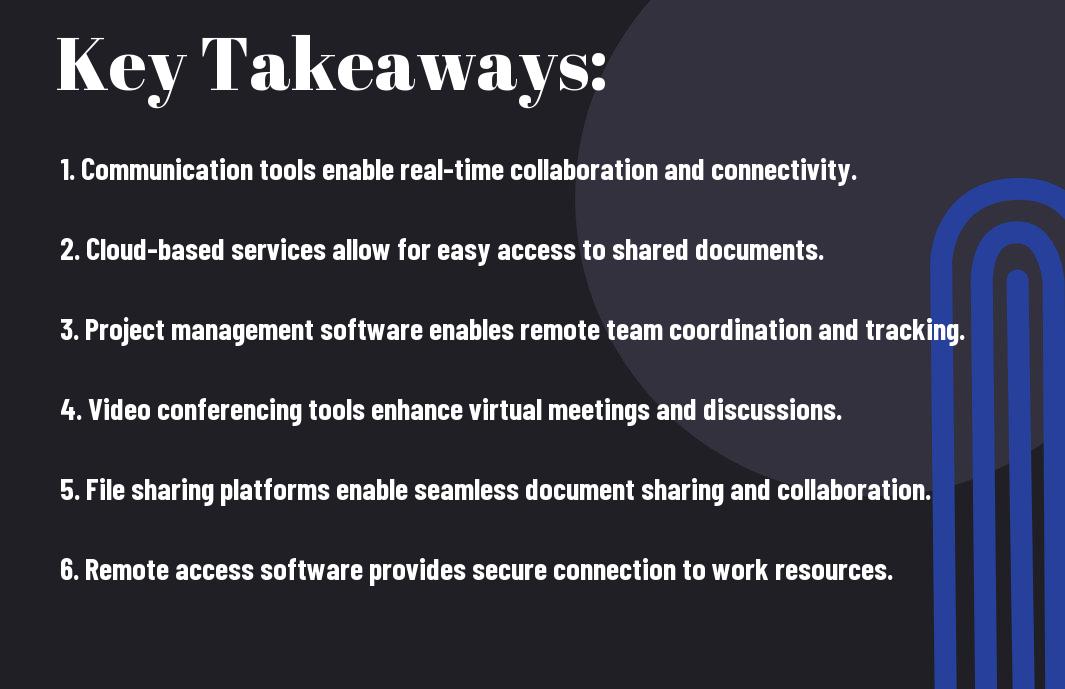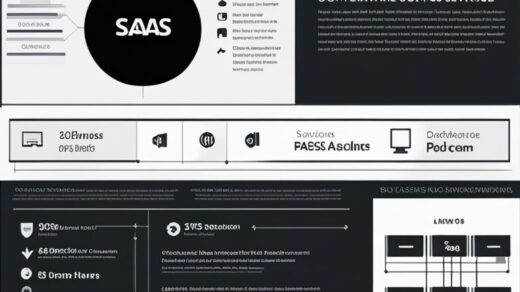Just imagine a world where you can work from any corner of the globe, collaborate seamlessly with your team members, and stay connected effortlessly. It all becomes possible, thanks to software services designed to enhance remote work and collaboration. In this post, we will explore into the ways these tools revolutionize the way you work, communicate, and stay productive no matter where you are. So, let’s explore how software services can truly transform your remote work experience and boost your team collaboration to new heights.
Key Takeaways:
- Increased Flexibility: Software services enable employees to work from anywhere, at any time, offering greater flexibility in managing work schedules and personal responsibilities.
- Enhanced Collaboration: Through features like video conferencing, chat platforms, and cloud-based file sharing, software services support real-time communication and collaboration among remote teams.
- Improved Productivity: By providing tools for project management, task tracking, and virtual meetings, software services help streamline workflows and keep remote teams organized and focused on achieving goals.

The Rise of Remote Work
The shift towards remote work
While remote work has been gaining popularity over the years, the COVID-19 pandemic accelerated this trend significantly. Companies around the world swiftly transitioned to remote work setups to ensure business continuity and the safety of their employees. This shift not only demonstrated the feasibility of remote work but also highlighted the benefits it can offer to both employees and employers.
Benefits of remote work for employees and employers
An increasing number of companies are embracing remote work as they recognize the advantages it brings. For employees, remote work offers flexibility in managing their schedules, eliminates commuting stress, and provides a comfortable work environment. Employers benefit from increased productivity, access to a broader talent pool, cost savings on office space, and improved work-life balance for employees.
This shift towards remote work has transformed the way businesses operate and approach work arrangements. As an employee, you can enjoy a better work-life balance, reduce stress from commuting, and leverage technology to collaborate effectively with your team no matter where you are located.
Software Services: The Enablers
One of the key factors that enable remote work and collaboration is the wide array of software services available to help streamline communication, project management, and file sharing. These tools play a crucial role in bridging the gap between team members working from different locations.
Communication tools for seamless collaboration
Software services like Slack, Microsoft Teams, and Zoom are imperative for facilitating real-time communication among remote teams. These platforms allow you to chat, video call, share files, and collaborate on projects in a virtual workspace. By providing a centralized communication hub, these tools help keep everyone on the same page, regardless of their physical location.
Project management software for organized workflows
Any successful remote team relies on project management software such as Trello, Asana, or Monday.com to keep tasks organized and priorities clear. These tools enable you to assign tasks, set deadlines, track progress, and allocate resources efficiently. With features like Gantt charts, Kanban boards, and team calendars, project management software ensures that everyone knows their role and responsibilities within the project.
Project management software is designed to enhance collaboration by providing a centralized platform where team members can access project details, communicate with each other, and track progress in real-time. By creating transparency and accountability, these tools help remote teams work together seamlessly towards a common goal.
File sharing and storage solutions for easy access
To ensure smooth collaboration, software services like Google Drive, Dropbox, and OneDrive are imperative for storing and sharing files securely in the cloud. These platforms allow you to access documents, presentations, and other files from anywhere, on any device. By enabling real-time editing, version control, and file syncing, file sharing solutions simplify the process of collaborating on documents with team members, even when they are miles apart.
To facilitate easy access and seamless sharing of files, you can integrate file sharing solutions directly into communication and project management tools. This integration allows you to link files to relevant conversations or tasks, ensuring that everyone has access to the most up-to-date information at all times.
Enhancing Collaboration
Once again, software services play a crucial role in enhancing collaboration among remote teams. These tools offer an array of features that make it easy for team members to work together seamlessly, irrespective of their physical location.
Real-time feedback and commenting features
With real-time feedback and commenting features, you can provide instant input on your team member’s work, ask questions, and collaborate more efficiently. These tools allow for quick revisions, reducing the back-and-forth exchange of emails and ensuring that everyone is on the same page.
Virtual meeting and video conferencing tools
Real-time virtual meeting and video conferencing tools take collaboration to the next level by enabling face-to-face communication, even when team members are miles apart. These tools allow for meetings, brainstorming sessions, and presentations to be conducted seamlessly, fostering a sense of togetherness and improving team dynamics.
Collaboration is made more accessible with the use of these tools as they facilitate real-time communication and interaction, bridging the gap between remote team members and creating a more connected work environment.
Task assignment and tracking capabilities
Feedback features in software services allow you to assign tasks to team members, set deadlines, and track progress effortlessly. This streamlines the workflow, ensures accountability, and helps in achieving project milestones efficiently.
Features such as task priority settings, progress trackers, and milestone notifications make it easier for you to oversee the progress of various tasks and projects, ensuring that everyone is aligned and working towards the same goals.
Overcoming Remote Work Challenges
Addressing communication breakdowns
To keep your remote team aligned and connected, it’s crucial to establish clear communication channels and protocols. Regular video calls, instant messaging platforms, and project management tools can help bridge the gap between team members. Encourage open communication and set expectations for response times to minimize misunderstandings and delays. By fostering a culture of transparent and efficient communication, you can overcome common challenges associated with remote work.
Managing time zones and language barriers
Language barriers and differing time zones can present significant challenges for remote teams. To address language barriers, consider implementing language translation tools or offering language training sessions for team members. In terms of time zones, establishing overlapping work hours and clearly communicating schedules and availability can help facilitate collaboration across different regions. Being sensitive to these differences and proactively finding solutions can enhance team cohesion and productivity.
The ability to navigate time zones and language barriers is crucial for effectively working with diverse and distributed teams. By prioritizing inclusivity and cultural awareness, you can create a more harmonious and productive remote work environment.
Ensuring data security and compliance
With the increasing reliance on digital platforms for remote work, it’s vital to prioritize data security and compliance. Implementing secure communication channels, using encryption methods, and enforcing strong password protocols can help safeguard sensitive information. Additionally, ensuring compliance with data protection regulations and regularly updating security measures can mitigate risks associated with remote work. By investing in robust cybersecurity practices, you can protect your organization’s data and uphold trust with both employees and clients.
This focus on data security and compliance not only safeguards confidential information but also demonstrates your commitment to responsible business practices in the digital age. By taking proactive steps to secure data and comply with regulations, you can instill confidence in your remote team and stakeholders alike.

Boosting Productivity
After How Can Technology Help Your Remote Team Collaborate…, you can leverage software services to enhance productivity in various ways.
Time tracking and performance analytics
Any successful remote team relies on effective time management and performance tracking. With software tools, you can easily monitor your team’s progress, track time spent on tasks, and analyze performance metrics. These insights allow you to identify bottlenecks, optimize workflows, and ensure that everyone stays on track with their responsibilities.
Automation and workflow optimization
Automation plays a crucial role in streamlining processes and saving time. By implementing automation features in your workflow, you can reduce manual tasks, minimize errors, and enhance efficiency. Additionally, software services offer workflow optimization tools that help in structuring tasks, setting dependencies, and automating repetitive actions to improve overall productivity.
This streamlined approach to work not only boosts productivity but also allows your team to focus on high-value tasks that require human input and creativity.
Personalized task management and prioritization
Management of tasks and priorities is key to productivity. Software services offer personalized task management tools that enable you to create to-do lists, set deadlines, and assign tasks to team members. By organizing and prioritizing tasks effectively, you can ensure that important assignments are completed on time and that everyone is clear on their responsibilities.
This personalized approach to task management helps in aligning team members towards common goals, improving coordination, and fostering a sense of accountability and ownership among team members.

The Future of Remote Work
Emerging trends in software services
Remote work is here to stay, and as technology continues to advance, we can expect to see emerging trends in software services that will further facilitate collaboration and productivity. From virtual reality tools for immersive meetings to advanced project management platforms that streamline workflows, the future of remote work is bright with possibilities. With the right software services, you can stay connected with your team and achieve seamless collaboration regardless of physical distance.
The role of AI and machine learning in remote collaboration
Machine learning and AI are revolutionizing the way teams collaborate remotely. These technologies can help automate repetitive tasks, provide valuable insights from data, and enhance communication among team members. By harnessing the power of AI and machine learning in your remote work setup, you can boost efficiency, creativity, and decision-making processes.
Plus, AI-driven tools offer personalized suggestions for improving work processes based on your team’s specific needs and performance metrics, ensuring that everyone stays on track and meets their goals.
Preparing for a remote work-dominated future
For a future where remote work dominates, it’s imperative to equip yourself with the right skills and tools to thrive in this new work environment. Investing in training programs that focus on remote collaboration, time management, and digital communication can give you a competitive edge in the job market. Additionally, staying updated on the latest software services and technologies can help you adapt to the evolving demands of remote work successfully.
Remote work offers flexibility and freedom, but it also requires self-discipline, strong communication skills, and a proactive mindset to succeed. By preparing yourself for a remote work-dominated future, you’ll be ready to embrace the opportunities that come with this modern way of working.
Summing up
As you have learned throughout this article, software services play a crucial role in facilitating remote work and collaboration. From project management tools to video conferencing platforms, these services have revolutionized the way we work and interact with our colleagues. If you want to examine deeper into how ERP systems are also contributing to remote work efficiency, check out How ERP Systems are Facilitating Remote Work. Embracing these technologies not only enhances productivity but also promotes seamless communication and teamwork, regardless of physical boundaries.
Q: How do software services help facilitate remote work?
A: Software services provide tools for communication, project management, and collaboration that allow employees to work together seamlessly from different locations. These tools include video conferencing, instant messaging, cloud storage, and virtual project boards.
Q: What are some examples of software services that aid collaboration in remote work settings?
A: Examples of software services that facilitate remote work and collaboration include Slack for messaging, Zoom for video conferencing, Trello for project management, Google Drive for cloud storage, and Asana for task tracking. These tools help remote teams stay connected and organized.
How do software services enhance productivity for remote workers?
A: Software services streamline communication, automate tasks, and provide real-time access to documents and information, which can boost productivity for remote workers. By enabling seamless collaboration and efficient workflows, software services help remote teams stay focused and achieve their goals.



